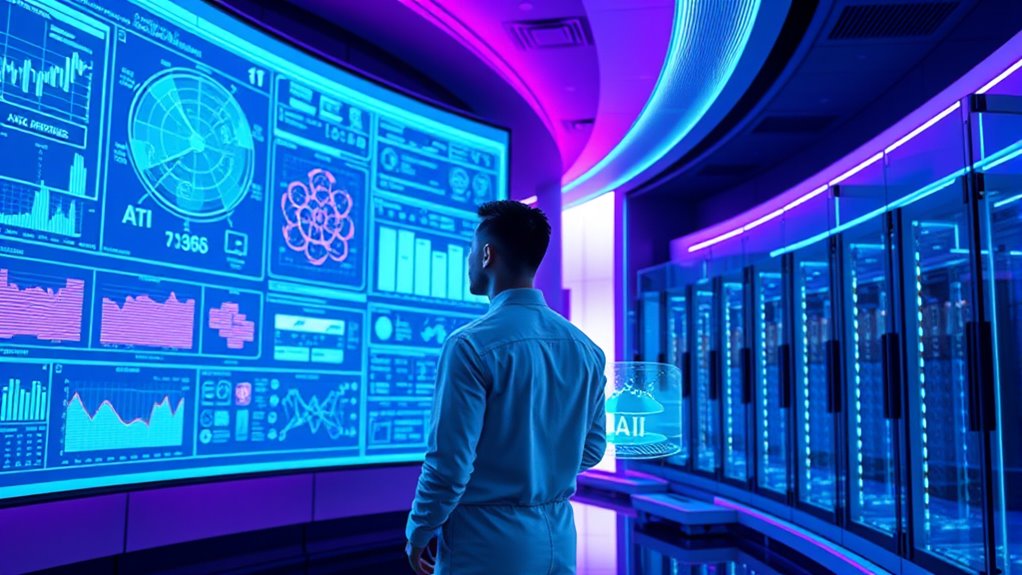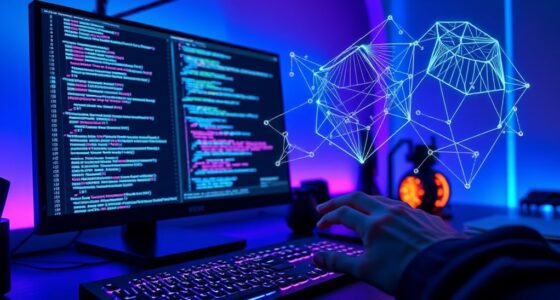AI automation is transforming your IT operations by streamlining routine tasks, enabling proactive monitoring, and enhancing security. It helps you detect potential issues early, reducing downtime and boosting system resilience. Automated processes improve accuracy and speed, freeing you from manual troubleshooting. Additionally, AI-powered tools strengthen security with real-time threat detection. If you want to see how these innovations can reshape your IT landscape, there’s plenty more to explore.
Key Takeaways
- AI automates routine tasks, reducing manual effort and human error in IT operations.
- Predictive analytics enable early detection of issues, preventing downtime and enhancing system resilience.
- AI-powered tools facilitate proactive monitoring, allowing real-time oversight and swift incident response.
- Automation streamlines security measures, identifying threats and vulnerabilities before breaches occur.
- Overall, AI shifts IT from reactive to predictive management, improving efficiency, decision-making, and service reliability.

Artificial intelligence automation is revolutionizing IT operations by streamlining routine tasks and enabling faster, more accurate decision-making. With AI-driven tools, you no longer have to spend hours manually monitoring systems or troubleshooting common issues. Instead, predictive analytics comes into play, analyzing vast amounts of data to forecast potential problems before they escalate. This proactive approach means you can address issues early, reducing downtime and preventing costly outages. By leveraging predictive analytics, your IT team gains the ability to anticipate system failures, capacity bottlenecks, or security threats before they impact your business.
Proactive monitoring becomes a core component of modern IT management with AI automation. Rather than reacting to issues after they occur, you can now continuously oversee your infrastructure in real time. AI algorithms sift through logs, network activity, and performance metrics to detect anomalies or signs of impending failure. This constant vigilance allows you to intervene before users notice any disruption, minimizing impact and improving service quality. As a result, your IT operations become more resilient and responsive, freeing up your team to focus on strategic initiatives instead of firefighting. Additionally, predictive analytics helps optimize resource allocation and capacity planning, further enhancing efficiency.
AI automation also simplifies complex tasks that traditionally required extensive manual effort. For instance, routine patching, system updates, and configuration changes can be automated, reducing human error and saving time. Moreover, AI-powered chatbots and virtual assistants support your help desk functions, providing instant responses to common queries and troubleshooting steps. This not only accelerates resolution times but also enhances user satisfaction. As these systems learn from interactions, they become more effective over time, further optimizing your IT workflows. Additionally, addressing AI vulnerabilities is crucial to ensure these automated systems are secure and trustworthy.
Security is another area transformed by AI automation. Predictive analytics helps identify vulnerabilities and potential threats by analyzing patterns and historical data. Proactive monitoring continuously scans for suspicious activity, enabling you to respond swiftly to cyber threats. This proactive stance significantly enhances your security posture, making it harder for attackers to exploit weaknesses or breach your systems. Additionally, integrating sleep and mental health practices, such as meditation and mindfulness, can improve overall focus and decision-making. In the context of IT management, maintaining mental clarity supports better strategic thinking and problem resolution. In essence, AI automation elevates your IT operations from reactive problem-solving to a proactive, predictive approach. It reduces manual effort, increases accuracy, and ensures higher system availability. Furthermore, incorporating data privacy considerations into your automation strategies helps protect sensitive information and comply with regulations, which is critical as data handling becomes more complex. This also relates to the importance of security and privacy in AI-driven environments. As a result, you can deliver more reliable services, respond swiftly to emerging issues, and focus on innovation rather than routine maintenance. This transformation empowers you to stay ahead in a competitive landscape, leveraging intelligent automation to drive efficiency and resilience across your IT environment.
Frequently Asked Questions
How Does AI Automation Impact IT Staff Roles and Job Security?
AI automation can lead to concerns about job displacement, but it also encourages skill evolution. You might find repetitive tasks automated, freeing you to focus on strategic and creative work. While some roles may change or diminish, your skills will need to adapt, making continuous learning essential. Embracing AI tools helps you stay relevant, ensuring your job security while expanding your capabilities in an evolving IT landscape.
What Are the Initial Costs of Implementing AI Automation in IT?
They say “you get what you pay for,” and when implementing AI automation, initial costs include expenses analysis and vendor selection, which shape your investment. You’ll need to budget for software licenses, infrastructure upgrades, and staff training. While upfront costs may seem high, careful planning helps you prevent surprises and ensures smooth integration, setting the foundation for long-term benefits in your IT operations.
How Does AI Handle Complex or Unpredictable IT Issues?
You might wonder how AI handles complex or unpredictable IT issues. AI uses predictive analytics to forecast potential problems before they escalate and anomaly detection to identify unusual patterns indicating issues. When faced with unexpected challenges, AI quickly analyzes data, adapts, and recommends solutions, often automating responses. This proactive approach helps you resolve issues faster, minimizing downtime and maintaining smooth operations even in unpredictable situations.
What Are the Potential Security Risks of Ai-Driven IT Automation?
You should be aware that AI-driven IT automation introduces potential security risks like AI vulnerability and data privacy concerns. Malicious actors could exploit AI systems, causing unintended actions or data breaches. Additionally, sensitive data processed by AI might be exposed if not properly secured. To mitigate these risks, guarantee robust security measures, regular updates, and transparent data handling policies to protect your systems and maintain trust.
How Can Small Businesses Benefit From AI Automation in IT Operations?
Did you know that 64% of small businesses report increased efficiency with AI automation? You can benefit by reducing costs through automated routine tasks, freeing up your team for strategic work. AI also offers scalability, meaning your IT operations can grow without substantial extra costs. Embracing AI automation helps you stay competitive, improve response times, and enhance security, all while keeping expenses manageable and operations flexible as your business expands.
Conclusion
As you embrace AI automation, you’ll find your IT operations become more efficient, proactive, and adaptable—truly a leap forward into the future of tech. With tools that anticipate issues like a modern-day Cassandra, you can resolve problems before they escalate. The integration of AI isn’t just a trend; it’s the dawn of a new era where your IT team can focus on innovation rather than firefighting. Stay ahead, and let AI be your guiding star.









